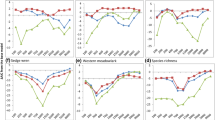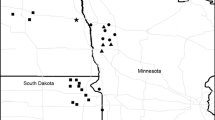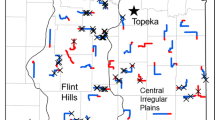Abstract
Context
The relative influence of habitat loss versus configuration on avian biodiversity is poorly understood. However, this knowledge is essential for developing effective land use strategies, especially for grassland songbirds, which have experienced widespread declines due to land use changes. Habitat configuration may be particularly important to grassland songbirds as configuration of habitat affects the extent of edge effects on the landscape, which strongly influences habitat use by grassland birds.
Objectives
We examined the relative influence of grassland amount and a measure of grassland configuration per se (Landscape Shape Index; LSI) on the relative abundance and richness of grassland songbirds.
Methods
In 2013, 361 avian point counts were conducted across 47, 2.4 km radii landscapes in south-west Manitoba, Canada, selected to minimize the correlation between grassland amount and configuration. We used generalized linear mixed-effects models within a multi-model inference framework to determine the relative importance of grassland amount and configuration on songbird response variables.
Results
Effects of grassland amount and configuration were generally weak, but effects of configuration were greater than grassland amount for most species. Relative abundance and richness of obligate species, and Savannah sparrows, showed a strong negative response to LSI, while grasshopper sparrows responded positively to grassland amount.
Conclusion
Our results suggest that habitat configuration must be considered when managing landscapes for conservation of grassland songbirds. Maintaining large, intact tracts of grasslands and limiting development of roads that bisect grassland parcels may be an effective means of maintaining grassland songbird diversity and abundance in northern mixed-grass prairies.





Similar content being viewed by others
References
Agriculture and Agri-Food Canada (2012) Manitoba land cover 17 class 2000-2002 for agricultural regions—30 m resolution, 1st edn. Agriculture and Agri-Food Canada, Ottawa, ON. http://open.canada.ca/data/en/dataset/16d2f828-96bb-468d-9b7d-1307c81e17b8. Accessed September 2013
Alldredge MW, Pollock KH, Simons TR, Collazo JA, Shriner SA (2007) Time-of-detection methods for estimating abundance from point-count surveys. Auk 124:653–664
Andren H (1994) Effects of habitat fragmentation on birds and mammals in landscapes with different proportions of suitable habitat: a review. Oikos 71:355–366
Andrews JE, Brawn JD, Ward MP (2015) When to use social cues: conspecific attraction at newly created grasslands. Condor 117:297–305
Barbieri MM, Berger JO (2004) Optimal predicative model selection. Ann Stat 32:870–897
Belisle M, Desrochers A, Fortin MJ (2001) Influence of forest cover on the movements of forest birds: a homing experiment. Ecology 82:1893–1904
Bender DJ, Contreras TA, Fahrig L (1998) Habitat loss and population decline: a meta-analysis of the patch size effect. Ecology 79:517–533
Bender DJ, Tischendorf L, Fahrig L (2003) Evaluation of patch isolation metrics for predicting animal movement in binary landscapes. Landscape Ecol 18:17–39
Brittingham MC, Temple SA (1983) Have cowbirds caused forest songbirds to decline? Bioscience 33:31–35
Brotons L, Wolff A, Guillaume P, Martin JL (2005) Effect of adjacent agricultural habitat on the distribution of passerines in natural grasslands. Biol Conserv 124:407–414
Buckland ST, Anderson DR, Burnham KP, Laake JL (1993) Distance sampling: estimating abundance of biological populations. Chapman and Hall, New York
Burnham KP, Anderson DR (2002) Model selection and multi-model inference: a practical information-theoretic approach. Springer, New York
Cade BS (2015) Model averaging and muddle multimodel inferences. Ecology 96:2370–2382
Caley MJ, Buckley KA, Jones GP (2001) Separating ecological effects of habitat fragmentation, degradation, and loss on coral commensals. Ecology 82:3435–3448
Coupland RT (1950) Ecology of mixed prairie in Canada. Ecol Monogr 20:271–315
Davis SK, Brigham RM, Shaffer TL, James PC (2006) Mixed-grass prairie passerines exhibit weak and variable responses to patch size. Auk 3:807–821
Davis SK, Brittingham M (2004) Area sensitivity in grassland passerines: effects of patch size, patch shape, and vegetation structure on bird abundance and occurrence in southern Saskatchewan. Auk 121:1130–1145
Davis SK, Fisher RJ, Skinner SL, Shaffer TL, Brigham RM (2013) Songbird abundance in native and planted grassland varies with type and amount of grassland in the surrounding landscape. J Wildl Manag 5:908–919
Davis AJ, Phillips ML, Doherty PF (2015) Nest success of Gunnison sage-grouse in Colorado, USA. PLOS ONE. https://doi.org/10.1371/journal.pone.0136310
Davis SK, Sealy SG (2000) Cowbird parasitism and nest predation in fragmented grasslands of Southwestern Manitoba. In: Smith JNM, Cook TL, Rothstein SI, Robinson SK, Sealy SG (eds) Ecology and management of cowbirds and their hosts. University of Texas Press, Austin, pp 220–228
Dunning JB, Danielson BJ, Pulliam HR (1992) Ecological processes that affect populations in complex landscapes. Oikos 65:169–175
Durán SM (2009) An assessment of the relative importance of wildlife management areas to the conservation of grassland songbirds in south-western Manitoba. Dissertation, University of Manitoba
Efford MG, Dawson DK (2009) Effect of distance-related heterogeneity on population size estimates from point counts. Auk 126:100–111
Ethier K, Fahrig L (2011) Positive effects of forest fragmentation, independent of forest amount, on bat abundance in eastern Ontario, Canada. Landscape Ecol 26:865–876
Ewers RM, Didham RK (2007) The effect of fragment shape and species’ sensitivity to habitat edges on animal population size. Conserv Biol 4:926–936
Fahrig L (1997) Relative effects of habitat loss and fragmentation on population extinction. J Wildl Manag 61:603–610
Fahrig L (1998) When does fragmentation of breeding habitat affect population survival? Ecol Modell 105:273–292
Fahrig L (2001) How much habitat is enough? Biol Conserv 100:65–74
Fahrig L (2002) Effect of habitat fragmentation on the extinction threshold: a synthesis. Ecol Appl 12:346–353
Fahrig L (2003) Effects of habitat fragmentation on biodiversity. Annu Rev Ecol Evol Syst 34:487–515
Fahrig L (2017) Ecological responses to habitat fragmentation per se. Annu Rev Ecol Evol Syst 48:1–23
Farnsworth GL, Pollock KH, Nichols JD, Simons TR, Hines JE, Sauer JR (2002) A removal model for estimating detection probabilities from point-count surveys. Auk 119:414–425
Fisher RJ, Davis SK (2011) Post-fledging dispersal, habitat use, and survival of Sprague’s pipits: are planted grasslands a good substitute for native? Biol Conserv 144:263–271
Fletcher RJ (2006) Emergent properties of conspecific attraction in fragmented landscapes. Am Nat 168:207–219
Fletcher RJ, Koford RR (2003) Spatial responses of bobolinks (Dolichonyx oryzivorus) near different types of edges in northern Iowa. Auk 120:799–810
Fletcher RJ, Ries L, Battin J, Chalfoun AD (2007) The role of habitat area and edge in fragmented landscapes: definitively distinct or inevitably intertwined? Can J Zool 85:1017–1030
Gelbard JL, Harrison S (2003) Roadless habitats as refuges for native grasslands: interactions with soil, aspect, and grazing. Ecol Appl 13:404–415
Grueber CE, Nakagawa S, Laws RJ, Jamieson IG (2011) Multimodel inference in ecology and evolution: challenges and solutions. J Evol Biol 4:699–711
Hargis CD, Bissonette JA, David JL (1998) The behavior of landscapes metrics commonly used in the study of habitat fragmentation. Landscape Ecol 13:167–186
Helzer CJ, Jelinski DE (1999) The relative importance of patch area and perimeter-area ratio to grassland breeding birds. Ecol Appl 9:1448–1458
Henderson AE, Davis SK (2014) Rangeland health assessment: a useful tool for linking range management and grassland bird conservation? Rangeland Ecol Manag 67:88–98
Herkert JR (1994) Status and habitat selection of the Henslow’s sparrow in Illinois. Wilson Bull 106:35–45
Heske EJ, Robinson SK, Brawn JD (1999) Predator activity and predation on songbird nests on forest-field edges in east-central Illinois. Landscape Ecol 14:345–354
Hutto RL, Young JS (2003) On the design of monitoring programs and the use of population indices: a reply to Ellingson and Lukacs. Wildl Soc Bull 31:903–910
Johnson DH (2008) In defense of indices: the case of bird surveys. J Wildl Manag 72:857–868
Johnson DH, Igl LD (2001) Area requirements of grassland birds: a regional perspective. Auk 118:24–34
Johnson RG, Temple SA (1990) Nest predation and brood parasitism of tallgrass prairie birds. J Wildl Manag 54:106–111
Keyel AC, Bauer CM, Lattin CR, Romero LM, Reed JM (2012) Testing the role of patch openness as a causal mechanism for apparent area sensitivity in a grassland specialist. Oecologia 169:407–418
Koper N, Schmiegelow FKA (2006) A multi-scaled analysis of avian response to habitat amount and fragmentation in the Canadian dry mixed-grass prairie. Landscape Ecol 21:1045–1059
Koper N, Walker D, Champagne J (2009) Nonlinear effects of distance to habitat edge on Sprague’s pipits in southern Alberta, Canada. Landscape Ecol 24:1287–1297
Kruess A, Tscharntke T (1994) Habitat fragmentation, species loss, and biological control. Science 264:1581–1584
Kurki S, Nikula A, Helle P, Linden H (2000) Landscape fragmentation and forest composition effects on grouse breeding success in boreal forests. Ecology 81:1985–1997
Lande R (1987) Extinction thresholds in demographic models of territorial populations. Am Nat 130:624–635
Larivière S (2004) Range expansion of raccoons in the Canadian prairies: review of hypotheses. Wildl Soc Bull 32:955–963
Leston L, Koper N, Rosa P (2015) Perceptibility of prairie songbirds using double-observer point counts. Gt Plains Res 1:53–61
Li X, He HS, Bu R, Wen Q, Chang Y, Hu Y, Li Y (2005) The adequacy of different landscape metrics for various landscape patterns. Pattern Recognit 38:2626–2638
Lloyd JD, Martin TE (2005) Reproductive success of chestnut-collared longspurs in native and exotic grassland. Condor 107:363–374
McDonald L (2017) The influence of patch size, landscape composition, and edge proximity on songbird densities and species richness in the northern tall-grass prairie. Dissertation, University of Manitoba
McGarigal K, Cushman SA (2002) Comparative evaluation of experimental approaches to the study of habitat fragmentation effects. Ecol Appl 12:335–345
McGarigal K, Marks BJ (1995) FRAGSTATS: spatial pattern analysis program for quantifying landscape structure. General technical report PNW-GTR-351 USDA Forest Service, Pacific Northwest Research Station, Portland, OR
McGarigal K, McComb WC (1995) Relationships between landscape structure and breeding birds in the Oregon Coast range. Ecol Monogr 65:235–260
Nakagawa S, Cuthill IC (2007) Effect size, confidence interval and statistical significance: a practical guide for biologists. Biol Rev 82:591–605
Nicols JD, Hines JE, Sauer JR, Fallon FW, Fallon JE, Heglund PJ (2000) A double-observer approach for estimating detection probability and abundance from point counts. Auk 117:393–408
Pasher J, Mitchell SW, King DJ, Fahrig L, Smith AC, Lindsay KE (2013) Optimizing landscape selection for estimating relative effects of variables on ecological responses. Landscape Ecol 28:371–383
Prairie Habitat Joint Venture (2014) Prairie Habitat Joint Venture implementation plan 2013-2020: the Prairie Parklands. Report of the Prairie Habitat Joint Venture. Environment Canada, Edmonton, AB
Quinn GP, Keough MJ (2002) Experimental design and data analysis for biologists. Cambridge University Press, Cambridge, UK
Ralph JC, Droege S, Sauer JR (1995) Managing and monitoring birds using point counts: standards and applications. Forest Service general technical report PSW-GTR-149, U.S. Department of Agriculture, Albany, CA
Renfrew RB, Ribic CA (2008) Multi-scale models of grassland passerine abundance in a fragmented system in Wisconsin. Landscape Ecol 23:181–193
Renfrew RB, Ribic CA, Nack JL (2005) Edge avoidance by nesting grasslands: a futile strategy in a fragmented landscape. Auk 122:618–636
Richardson AN, Koper N, White KA (2014) Interactions between ecological disturbances: burning and grazing and their effects on songbird communities in northern mixed-grass prairies. Avian Conserv Ecol 2:5
Robinson SK, Thompson FR, Donovan TM, Whitehead DR, Faaborg J (1995) Regional forest fragmentation and the nesting success of migratory birds. Science 267:1987–1990
Rotella JT, Madden EM, Hansen AJ (1999) Sampling considerations for estimating density of passerines in grasslands. Stud Avian Biol 19:237–243
Royle JA (2004) N-mixture models for estimating population size from spatially replicated counts. Biometrics 60:108–115
Sargeant AB, Greenwood RJ, Sovada MA, Shaffer TL (1993) Distribution and abundance of predators that affect duck production—Prairie Pothole region. Resource Publication 194. United States Department of the Interior Fish and Wildlife Service, Washington, DC
Sauer JR, Hines JE, Fallon JE, Pardieck KL, Ziolkowski DJ, Link WA (2011) The North American breeding bird survey, results and analysis 1966-2009. Version 3.23.2011 USGS Patuxent Wildlife Research Center, Laurel, MD
Saura S, Carballal P (2004) Discrimination of native and exotic forest patterns through shape irregularity indices: an analysis in the landscape of Galicia, Spain. Landscape Ecol 19:647–662
Saura S, Torras O, Gil-Tena A, Pascual-Hortal L (2008) Shape irregularity as an indicator of forest biodiversity and guidelines for metric selection. In: Lafortezza R, Sanesi G, Chen J, Crow TR (eds) Patterns and processes in forest landscapes. Springer, Netherlands, pp 167–189
Schielzeth H (2010) Simple means to improve the interpretability of regression coefficients. Methods Ecol Evol 1:103–113
Schmidt JH, McIntyre CL, MacCluskie MC (2013) Accounting for incomplete detection: what are we estimating and how might it affect long-term passerine monitoring programs? Biol Conserv 160:130–139
Schmiegelow FKA, Mönkkönen M (2002) Habitat loss and fragmentation in dynamic landscapes: avian perspectives from the boreal forest. Ecol Appl 12:375–389
Schwenk WC, Donovan TM (2011) A multispecies framework for landscape conservation planning. Conserv Biol 25:1010–1021
Shahan JL, Goodwin BJ, Rundquist BC (2017) Grassland songbird occurrence on remnant prairie patches is primarily determined by landscape characteristics. Landscape Ecol 32:971–988
Sliwinski M, Koper N (2012) Grassland bird responses to three edge types in a fragmented mixed-grass prairie. Avian Conserv Ecol 7:6
Sliwinski M, Koper N (2015) Managing mixed-grass prairies for songbirds using variable cattle stocking rates. Rangeland Ecol Manag 68:470–475
Smith AC, Koper N, Francis CM, Fahrig L (2009) Confronting collinearity: comparing methods for disentangling the effects of habitat loss and fragmentation. Landscape Ecol 24:1271–1285
Smith RL (1963) Some ecological notes on the grasshopper sparrow. Wilson Bull 75:159–165
Stoudt JH (1982) Habitat use and productivity of canvasbacks in southwestern Manitoba, 1961-72. U.S. Fish and Wildlife Service Special Science report 248
Trzcinski MK, Fahrig L, Merriam G (1999) Independent effects of forest cover and fragmentation on the distribution of forest breeding birds. Ecol Appl 9:586–593
Turner MG, Gardner RH, O’Neil RV (2001) Landscape ecology in theory and practice: patterns and process. Springer, New York
Van Horne B (1983) Density as a misleading indicator of habitat quality. J Wildl Manag 47:893–901
Venier L, Fahrig L (1996) Habitat availability causes the species abundance-distribution relationship. Oikos 76:564–570
Vickery PD, Hunter ML, Wells JV (1992) Is density an indicator of breeding success? Auk 109:706–710
Vickery PD, Tubaro PL, Da Silva JMC, Peterjohn BG, Herkert R, Cavalcanti RB (1999) Conservation of grassland birds in the western hemisphere. Stud Avian Biol 19:2–26
Wang X, Blanchet G, Koper N (2014) Measuring habitat fragmentation: an evaluation of landscape pattern metrics. Methods Ecol Evol 5:634–646
Whitmore RC (1981) Structural characteristics of grasshopper sparrow habitat. J Wildl Manag 45:811–814
Wilson SD, Belcher JW (1989) Plant and bird communities of native prairie and introduced Eurasian vegetation in Manitoba, Canada. Conserv Biol 3:39–44
Winter M, Faaborg J (1999) Patterns of Area sensitivity in grassland-nesting birds. Conserv Biol 13:1424–1436
Winter M, Johnson DH, Faaborg J (2000) Evidence for edge effects on multiple levels: artificial nests, natural nests, and distribution of nest predators in Missouri tallgrass prairie fragments. Condor 102:256–266
Winter M, Johnson DH, Shaffer JA, Donovan TM, Svedarsky WD (2006) Patch size and landscape effects on density and nesting success of grassland birds. J Wildl Manag 1:158–172
With KA, King AW (1999) Extinction thresholds for species in fractal landscapes. Conserv Biol 13:314–326
With KA, Pavuk DM (2011) Habitat area trumps fragmentation effects on arthropods in an experimental landscape system. Landscape Ecol 26:1035–1048
With KA, Pavuk DM (2012) Direct versus indirect effects of habitat fragmentation on community patterns in experimental landscapes. Oecologia 170:517–528
Acknowledgements
We thank the many landowners for their support, E. Prokopanko and M. Garcia for their assistance in the field, and L. Fahrig, M. Manseau and two anonymous reviewers for their comments and constructive feedback on earlier drafts of the manuscript. Funding for this work was provided by the Manitoba Graduate Scholarship, Environment and Biodiversity Stewardship Fund (Manitoba Conservation), Ghostpine Environmental Service LTD Prairie Research Award, Manitoba Hydro Graduate Scholarship, Richard C. Goulden Memorial Award, Natural Sciences and Engineering Research Council, Canadian Foundation for Innovation, the Manitoba Research and Innovations Fund, and Clayton H. Riddell Endowment Fund, University of Manitoba.
Author information
Authors and Affiliations
Corresponding author
Electronic supplementary material
Below is the link to the electronic supplementary material.
Rights and permissions
About this article
Cite this article
Lockhart, J., Koper, N. Northern prairie songbirds are more strongly influenced by grassland configuration than grassland amount. Landscape Ecol 33, 1543–1558 (2018). https://doi.org/10.1007/s10980-018-0681-5
Received:
Accepted:
Published:
Issue Date:
DOI: https://doi.org/10.1007/s10980-018-0681-5




